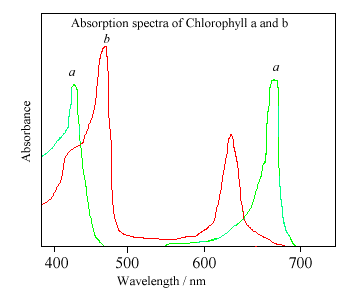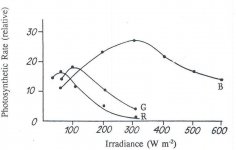knna
Member
We were having a talk about how different lamps induce differences in photosynthesis and other factors of plant development. As I think this topic deserves its own thread, I open this and translate the posts that arised the question, in the Ceramic Metal Halide thread (http://www.icmag.com/ic/showthread.php?t=72215&page=190), in order to not highjack that thread and continue here.
People were talking about the output in lm of CMH and HPS, so I posted this:
"An optical watt (emitted light) of CMH only produces 285lm, vs 385lm of a typical HPS. So, its not the HPS emits more light, but more lm: the light they emits produces an higher brightness sensation for humans, but not for plants.
1000lm of CMH (4200K) holds near 16 micromols of photons. While 1000lm of HPS holds 11.5-12uE.
So 31000lm of CMH=496uE
49000lm of HPS=563 to 588uE.
So, the HPS emits more photons, but there is way less difference than lm rating leads to think. "
etinarcadiaego posted:
"right we agreed that HPs emits more lumens, which is a standard created by people to measure as you mention, perceived light. Check this out, a great read about lumens and what they do and don't measure.
I followed the rest of your post, but it didn't really quantify the amount of photosynthetic reactive energy emitted by a particular bulb, though I don't think that's what you had in mind."
My next post
"Great link, its difficult to find pages that explain those concepts well.
Yeap, I did not wanted to enter into the conflictive topic of induced photosynthesis by different wavebands and light spectrums, but just state the actual light emission of both lamps in the unit meangliful for plants, micromoles of photons per second (uE).
But the photosynthetic response of plants is basically flat to all absorbed photons into the PAR range (400-700nm), irrespective of its wavelenght. There are differences, but they are small, and mainly produced by the different absorbance of each wavelenght, as one absorbed photon usually has the same potential of induce photosynthesis whatever wavelenght it is.
Its impossible to state how much photosynthesis induces photons of different wavelenght in the practice, due the adaptative nature of plants. But its possible to state some orientative figures, based on the data of botanist experiments, for unsaturated photosynthesis.
Using the Inada curve, which sum the effect of absorbance and quantum yield, the 4200K CMH result on a efficacy of 75%, and a typical HPS spectrum (phillips Son T), an efficacy of 78%.
Using the McCree curve and the cannabis absorbance of photons (thus, a more accurate way), it result on a efficacy of 74% (CMH) and 80% (HPS) respectively, when applied to the baseline of photon emission. But in the practice, difference is smaller. And when using high light levels, the efficacy of the bluiser CMH is way less affected (in the negative way) than its than of HPS. And the effect of higher UV (below 400nm), with reduced but positive photosynthesis induction narrow the edifference even more, as noted by hoosierdaddy
So resuming, there is little difference in efficacy of photons inducing photosynthesis for both type of lamps, and the photon output of each is a very good sign of their potential. And always take in mind that there are other things apart of photosynthesis, that are impossible to quantify (leaves to calixes ratio, production of resin, effects over cannabinoid profile...) "
Note: I deleted the quote of the last post, as etinarcadiaego has paste it
People were talking about the output in lm of CMH and HPS, so I posted this:
"An optical watt (emitted light) of CMH only produces 285lm, vs 385lm of a typical HPS. So, its not the HPS emits more light, but more lm: the light they emits produces an higher brightness sensation for humans, but not for plants.
1000lm of CMH (4200K) holds near 16 micromols of photons. While 1000lm of HPS holds 11.5-12uE.
So 31000lm of CMH=496uE
49000lm of HPS=563 to 588uE.
So, the HPS emits more photons, but there is way less difference than lm rating leads to think. "
etinarcadiaego posted:
"right we agreed that HPs emits more lumens, which is a standard created by people to measure as you mention, perceived light. Check this out, a great read about lumens and what they do and don't measure.
I followed the rest of your post, but it didn't really quantify the amount of photosynthetic reactive energy emitted by a particular bulb, though I don't think that's what you had in mind."
My next post
"Great link, its difficult to find pages that explain those concepts well.
Yeap, I did not wanted to enter into the conflictive topic of induced photosynthesis by different wavebands and light spectrums, but just state the actual light emission of both lamps in the unit meangliful for plants, micromoles of photons per second (uE).
But the photosynthetic response of plants is basically flat to all absorbed photons into the PAR range (400-700nm), irrespective of its wavelenght. There are differences, but they are small, and mainly produced by the different absorbance of each wavelenght, as one absorbed photon usually has the same potential of induce photosynthesis whatever wavelenght it is.
Its impossible to state how much photosynthesis induces photons of different wavelenght in the practice, due the adaptative nature of plants. But its possible to state some orientative figures, based on the data of botanist experiments, for unsaturated photosynthesis.
Using the Inada curve, which sum the effect of absorbance and quantum yield, the 4200K CMH result on a efficacy of 75%, and a typical HPS spectrum (phillips Son T), an efficacy of 78%.
Using the McCree curve and the cannabis absorbance of photons (thus, a more accurate way), it result on a efficacy of 74% (CMH) and 80% (HPS) respectively, when applied to the baseline of photon emission. But in the practice, difference is smaller. And when using high light levels, the efficacy of the bluiser CMH is way less affected (in the negative way) than its than of HPS. And the effect of higher UV (below 400nm), with reduced but positive photosynthesis induction narrow the edifference even more, as noted by hoosierdaddy
So resuming, there is little difference in efficacy of photons inducing photosynthesis for both type of lamps, and the photon output of each is a very good sign of their potential. And always take in mind that there are other things apart of photosynthesis, that are impossible to quantify (leaves to calixes ratio, production of resin, effects over cannabinoid profile...) "
Note: I deleted the quote of the last post, as etinarcadiaego has paste it






